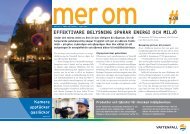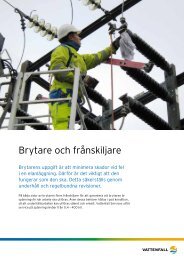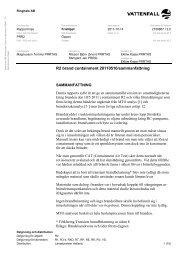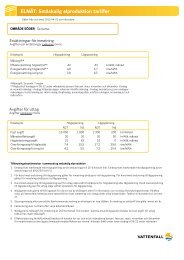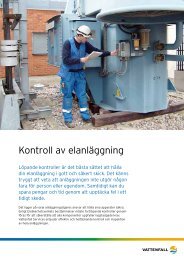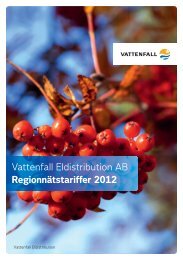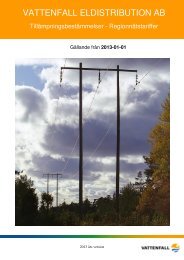This environmental impact assessment for Kriegers flak ... - Vattenfall
This environmental impact assessment for Kriegers flak ... - Vattenfall
This environmental impact assessment for Kriegers flak ... - Vattenfall
You also want an ePaper? Increase the reach of your titles
YUMPU automatically turns print PDFs into web optimized ePapers that Google loves.
there are technical and economic limitations. If built<br />
shallower than 10 meters there is a greater conß ict with<br />
the surrounding eco system as the sunlight penetrates<br />
the water causing a more abundant ß ora and fauna.<br />
The latter problem occured when planning the German<br />
project Adlergrund, where the rich ß ora and fauna was<br />
especially important, as the area was protection worthy<br />
<strong>for</strong> resting birds.<br />
e) Distance to the coast<br />
The wind farm should be placed at a distance that limits<br />
the effects on the landscape picture and reduces the<br />
disturbance of the visual experience. At the same time<br />
the wind farm should be placed at a distance that does<br />
not incur costs that are too high when connecting to the<br />
electrical grid (as mentioned above the costs <strong>for</strong> 1km<br />
sea cable is approximately Þ ve million SEK). Sweden<br />
Offshore is of the opinion that the optimal distance is<br />
between 20 and 40 km.<br />
f) Seabed conditions<br />
The selected area should be good <strong>for</strong> grounding the<br />
foundations, such as sand and moraine. Loose sand<br />
deposits can however be inappropriate if they are subjected<br />
to transport and movement through currents and<br />
waves. The seabed substratum is also of importance.<br />
Rocky and uneven seabeds makes the grounding of the<br />
foundation harder. In most cases the seabed conditions<br />
do not cause a hazard to the establishment of<br />
wind farms but can inß uence the method of grounding<br />
which in turn has an effect on the economy.<br />
g) Local wind conditions<br />
The wind energy is proportionate to the cube of the<br />
wind speed. <strong>This</strong> means that if the wind speed is<br />
doubled the wind energy is increased eightfold. The<br />
local wind condition is <strong>for</strong> this reason of high importance.<br />
Offshore wind resources generally increase in<br />
proportion to the distance from the coast. According<br />
to STEM, the main criteria <strong>for</strong> suggesting an area of<br />
national interest <strong>for</strong> wind power is that the wind energy<br />
content should be at least 3 800 kWh/m2/year at the<br />
height of 80 m above ground/sea (Wind power: Distribution<br />
of the national planning target and criteria <strong>for</strong><br />
areas of national interest, STEM, ER 16:2003). <strong>This</strong><br />
corresponds to an average wind speed of approximate-<br />
ALTERNATIVE LOCATIONS 45<br />
ly 7,2m/s per year.<br />
h) Conditions <strong>for</strong> grid connection<br />
Connection points with available capacity must be<br />
located within reasonable distance from the coast. In<br />
the report “Overall conditions <strong>for</strong> large-scale wind<br />
power development offshore and in mountain regions”,<br />
The Swedish Transmission System Operator, Svenska<br />
Kraftnät, on appointment from the government,<br />
showed the effects of large-scale wind power development<br />
offshore and in mountain regions. In this report<br />
Svenska Kraftnät stated that the conditions <strong>for</strong> connection<br />
are most favourable in locations where there<br />
has previously been electricity production but that now<br />
are redundant. The table below shows the production<br />
sources that are redundant and where connection of<br />
wind power production was considered relatively easy.<br />
Out of these four locations Barsebäck is the only<br />
remaining redundant production site included in the<br />
report. The other sites are back in production and can<br />
produce electricity when needed. The probable development,<br />
according to Svenska Kraftnät, is that wind<br />
farms with installed capacity of about one hundred<br />
Power plant Capacity [MW]<br />
Barsebäck 600<br />
Stenungsund 820<br />
Marviken 200<br />
Bråvalla 240<br />
MW primarily get connected to the regional grid and<br />
that these then need to be rein<strong>for</strong>ced. The reasons<br />
are that it is generally cheaper to connect to a lower<br />
voltage grid, and that the regional grids are closer to<br />
the coast than the transmission grid, which reduces<br />
distance, and thereby the connection costs, between the<br />
wind farm and the grid. Larger wind farms may need<br />
to be connected directly to the transmission grid when<br />
the regional grid is incapable of accepting the capacity.<br />
i) Environmental restrictions<br />
When choosing alternative locations, the local environment<br />
is important. The wind farm should not inß uence<br />
or encroach areas that are ofÞ cially protected or<br />
ecologically sensitive.





